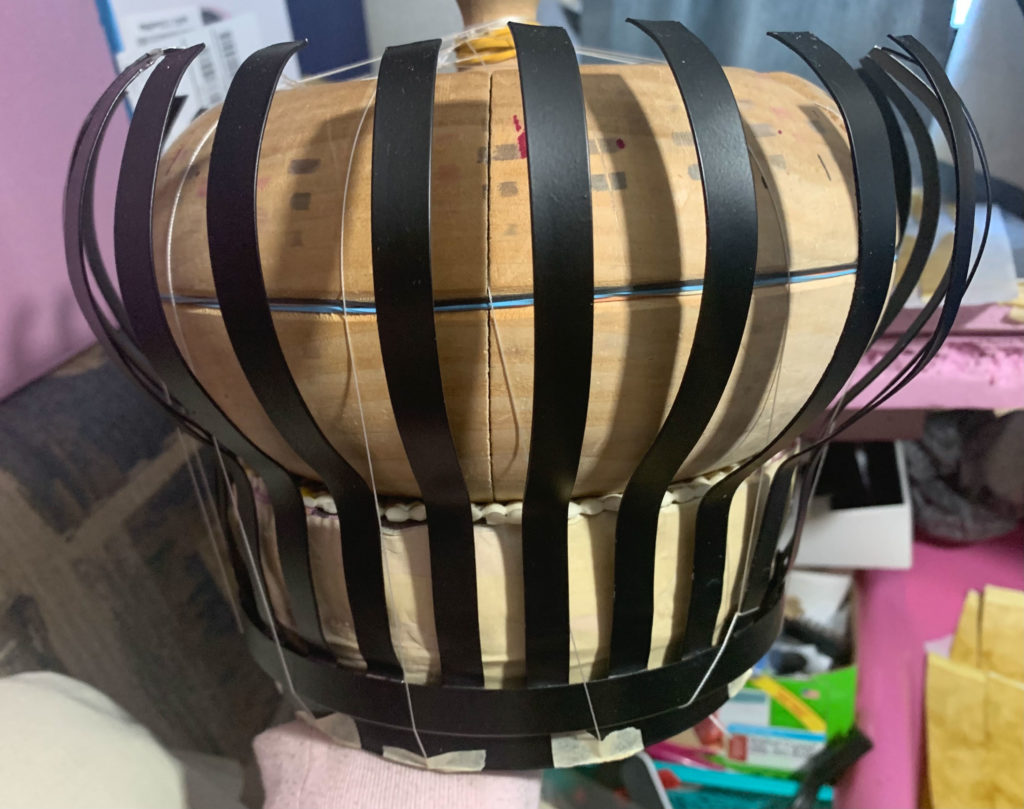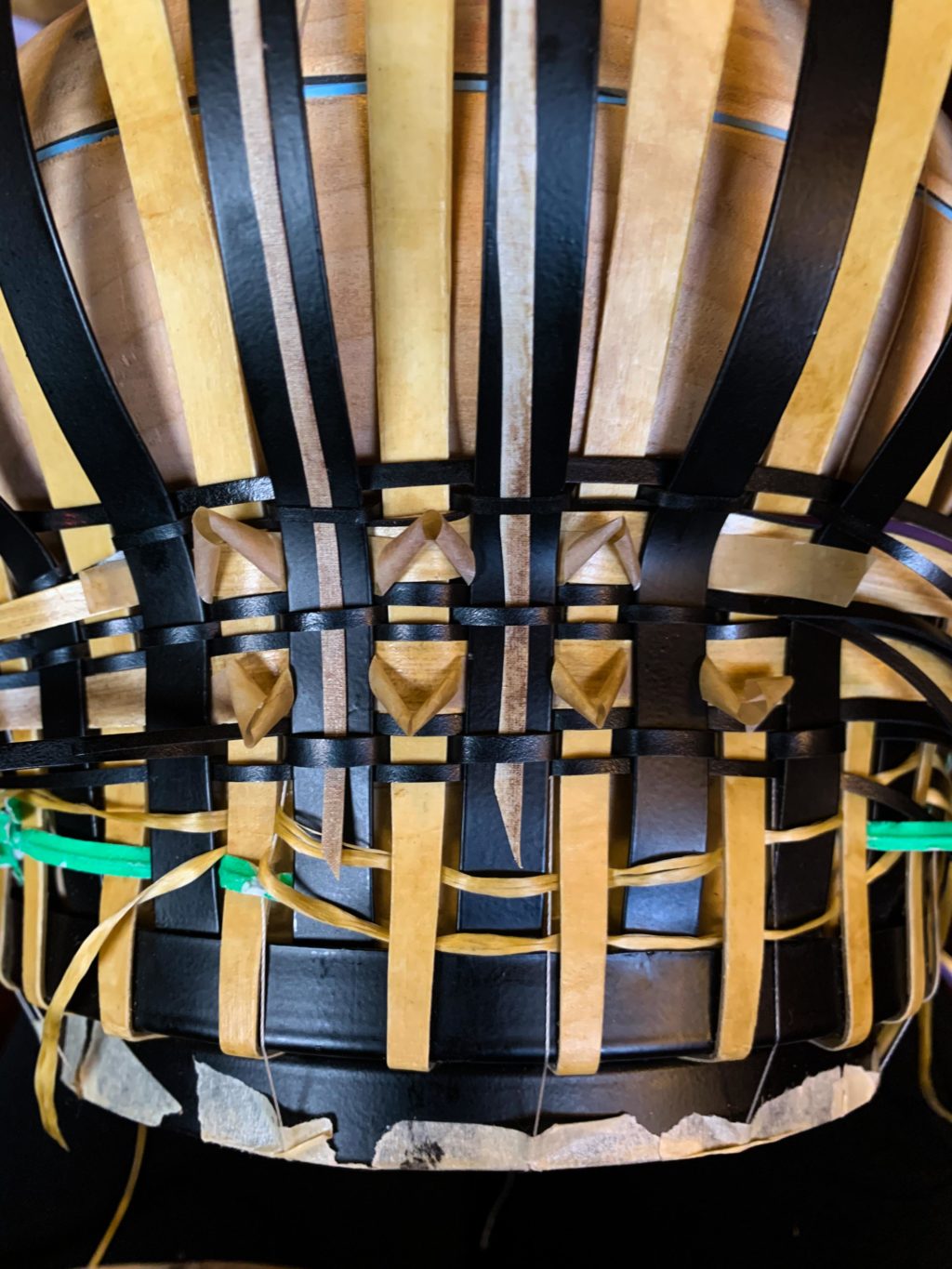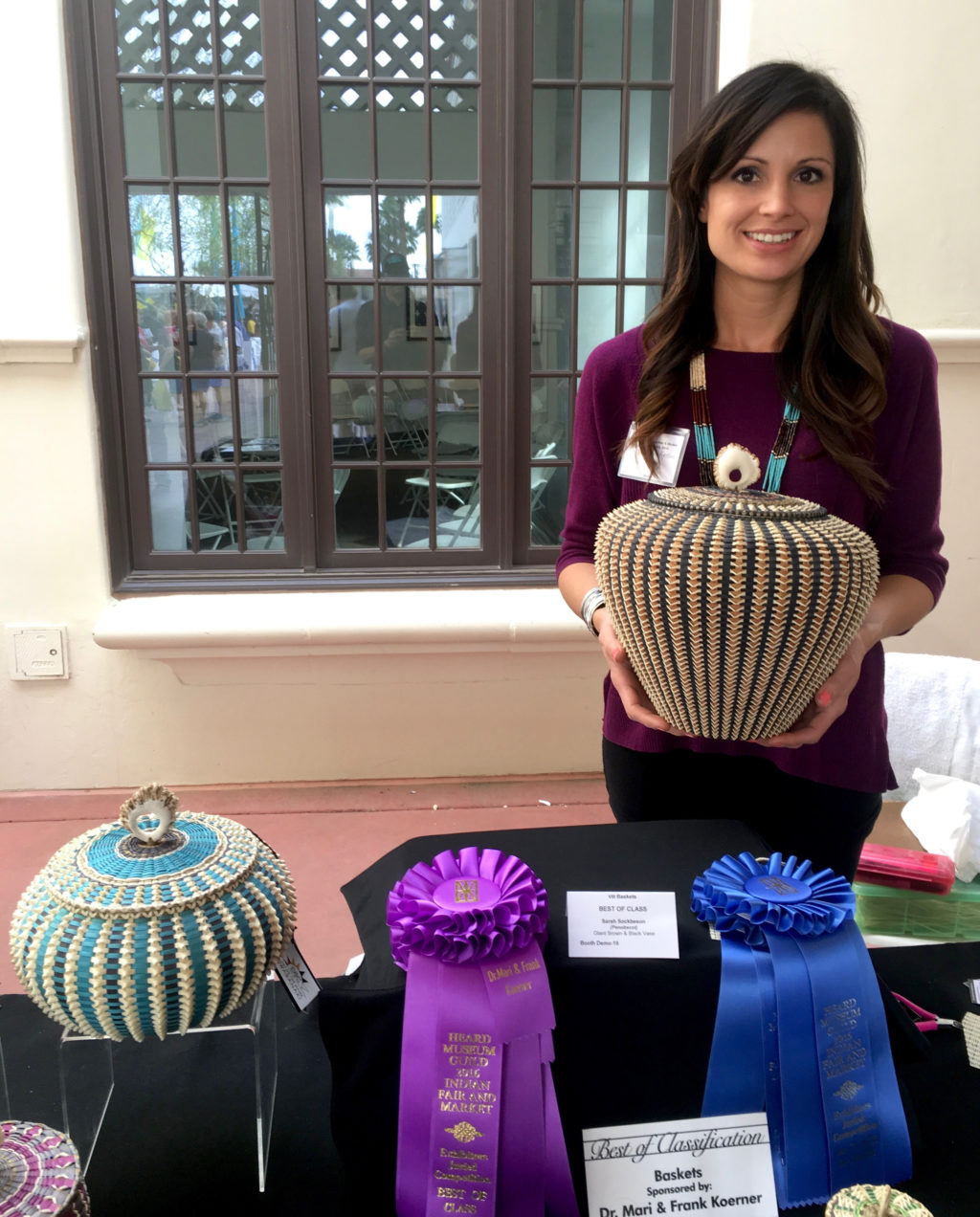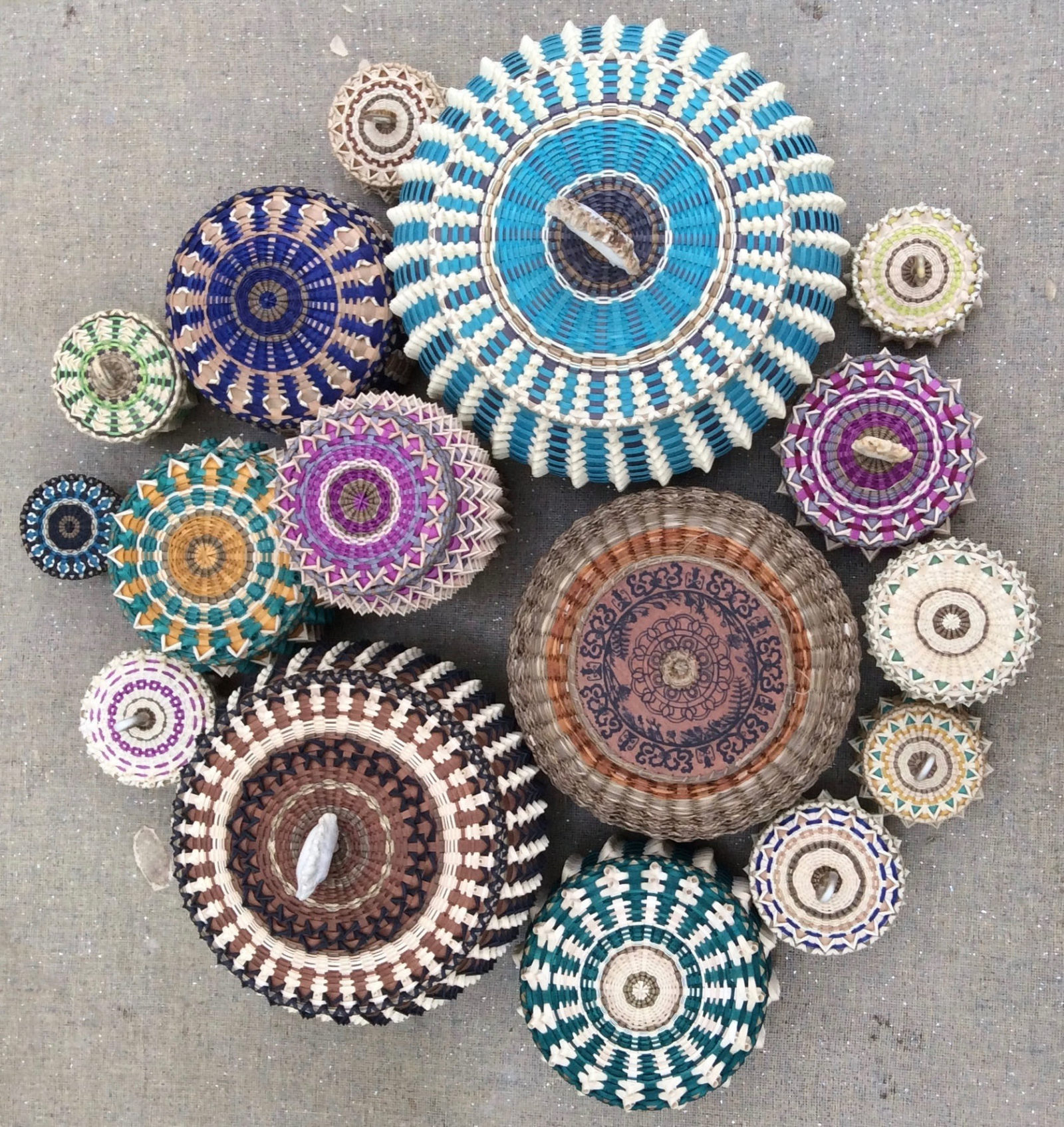Sarah Sockbeson, member of the Penobscot Nation, creates traditional yet contemporary brown ash and sweetgrass baskets, among other artistic disciplines. She is part of a new generation of basketmakers who’ve pushed the boundaries of Wabanaki cultural art to an exciting new level. With her contemporary and innovative vision and approach, she seeks to not only to protect and preserve a precious & culturally important art form, but to break apart the stereotypes, to educate, and produce works that are an accurate representation of her people. Growing up on and off Indian Island, (the reservation /ancestral homelands of the Penobscot people), Sarah was exposed to native art at an early age, and had an interest in traditional baskets in particular. Coming from a long line of basketmakers, it was unfortunate that the line of knowledge stopped when her great-grandmother passed away before teaching the next generation. Fortunately in 2004, Sarah was introduced to the Maine Indian Basketmakers Alliance, an organization dedicated to preserving traditional knowledge, when she had the opportunity to apprentice with Jennifer Sapiel, Penobscot. So began her journey into the world of Wabanaki basketry. Since then, Sarah has honed her skills with each basket woven, becoming an integral part of the Wabanaki arts community. While her work is undeniably tied to cultural tradition, she infuses a style all her own, in the hopes that her work will serve as an inspiration to future generations of Native American artists.
How has COVID affected your Kindling Fund project At the Intersection of Tradition and Innovation?
Unfortunately, it has altered the timeline for completing some of the intended goals of the project due to the social distancing mandates, yet in some ways, it has allowed me more opportunities to expand upon my point of view as a whole. In general, the pandemic has completely changed my perspective and outlook on how I ordinarily conduct my business, so I’ve chosen to take some time to try to reflect upon my current strategies and process. Due to the nature of social distancing, and having a business that relies upon direct to consumer sales channels, the pandemic has introduced challenges of which, I think, creativity lends itself aptly to the exploration and discovery of new ideas and solutions, much like the intended purpose of my project: thinking about traditional art with an alternative or innovative mindset. So I’ve really tried to focus and channel much of my energy and focus into how I can not only adapt and expand my way of looking at my art form, materials, and processes, but also to broaden my potential reach to audiences while we all adjust to ‘distance’ as our new way of life.
I was at a show in Phoenix when COVID began, I thought ‘oh this will be two weeks and then I’ll be home’. When I realized things weren’t changing, I ended up flying back to the East coast, and stayed with family to help out with my niece who didn’t have school.
When the lockdowns looked like they were going to continue on indefinitely, I began thinking about ways I could change or adapt my business and approach. I started to zero in on some of the ideas and projects that, in the past I had always pushed to the back burner due to time and my (usually) hectic show schedule. That’s pretty much the majority of where I’ve devoted most of my energy. What I had initially been able to complete in terms of my Kindling project timeline, was a good percentage of the research and experimentation I had hoped to develop, sourcing and gathering materials, and utilizing some of the new materials I had chosen to work with. The materials we use, in our traditional basketry, are Brown or Black Ash and Sweetgrass. When we found out about the invasive species, the Emerald Ash Borer Beetle, potentially affecting our natural materials, already decimating populations of Ash in other parts of the country, that was sort of the beginning of what inspired me to want to explore working with alternative materials and to experiment with recycled items. I wanted materials that mimic or recreate the look and feel of the Ash that I could still apply the same techniques and traditional knowledge to. I’ve been able to do research and play with different materials, and start work on a couple pieces. The second portion of my project involved having a workshop, with a group of participants together and working hands on in a space where we could all work with different materials and have a collective session with traditional artists experimenting and seeing what would come out of that experience. I haven’t been able to do that portion of it yet, but still hope to at a future time, when it’s safe to do so.

What are some of the non-traditional materials you have had success with?
One of the most rewarding parts of the project has been having the opportunity to explore and experiment with materials outside of the box, that’s really what I love doing most. When I was in Phoenix early last year, I ended up working with a jeweler and learning metalsmithing techniques. That got me thinking about how I can introduce various metal components into the project or even create pieces that could be considered wearable art. The experience really pushed my ideas to another level, and brought new concepts to the forefront, which I hope to further flesh out, as I continue to work on pieces for the project. So I’m thankful to have had that chance to learn some new techniques and expand my knowledge of working with other materials. So I would say, it was an unexpected yet fortunate side effect of being quarantined at the beginning of the pandemic.
While exploring alternative materials to Ash and Sweetgrass, I’ve really just been constantly considering and imagining the possibilities of anything I happen to come across, gathering and stockpiling quite the variety of mediums, many of which might be labeled as trash or recycling type items. I’ve been gathering old cords and wires, like whenever somebody’s iPhone charger breaks, I’ve been collecting those to weave with. I played around to see how it could potentially be woven or incorporated into a piece, and have come up with a few designs that include those and other types of wires. The other materials I’ve been investigating are various forms of plastics, like packaging materials, PVC document folders, vinyl pieces, plastic bottles, containers, construction type components. One of the pieces I’ve been working on uses wires of various sizes, metal, the document folders, fabric, and fusible interfacing which I used to laminate pieces to the extent I was able to achieve a similar thickness resembling the feel of the Ash I ordinarily weave with. I didn’t want it to be see-through, but to have more of a translucent effect. I’m hoping to produce a piece that will become a light fixture, to achieve a luminescent or glowing effect, and will be able to be hung like a chandelier. I also used vellum paper that I dyed and layered upon the folders, giving an opaque parchment look. I’ve also experimented with vinyl strappings that are normally used for shipping pallets, which my friend saved for me from their warehouse. That’s been really cool because it really mimics the feel, flexibility and rigidity of the wood in a way. I think it has potential to work really well in some of the designs I have planned.

So many new approaches. Have you worked with anything that really didn’t work or that you didn’t enjoy the material?
Well, sort of, a few different things. I’m not even sure exactly what the usual purpose was, but I found something that intrigued me from a construction site. I think it’s the backing material that you would pull off of shingles, it’s a rubbery membrane type material. I just loved the feeling of it. It was thin and see through, and had this rubbery, flexible, stretchy kind of feeling to it. I thought that would be cool to try and incorporate somehow, but I haven’t figured out quite how yet. I don’t really like to write off any items in particular, because I like the idea of making anything potentially work. I just think ‘hmm, how could we do something with this?’.
In this creative approach of introducing new materials and techniques into the traditional art form, have you been met with any resistance to altering the tradition?
I personally have not experienced that but only because I haven’t encountered people in a while which perhaps may be the reason for that. In general, what I have experienced in the past, when stepping outside of the traditional materials, or using materials that are not customary of the tradition or of a certain time period, I’ve heard comments. I have definitely experienced people saying things that aren’t necessarily positive, but they have an opinion on it for sure. A lot of times it’s because they think ‘that’s cheating’ if you use that material, that wasn’t available during ‘this time period’. To me that mentality or approach to things is just so narrow. In general I feel like Native art has been evolving over time, and it continues to do so. I think Native people are very resourceful, and have always used what’s available in creative ways. I feel like when people criticize or have expectations of our work fitting inside a certain mold, I would say that perspective has the potential to limit or discourage artists from reaching what they are capable of. It’s like saying ‘This is what we expect from you. You must only work within these confines and you have to do what the consumer expects of you’ and I think that can be really harmful to the tradition and to cultural processes in general, because it doesn’t allow an artist to broaden what they work with, or think about things differently or innovatively. It stifles their voice, it doesn’t validate Native artists as being the contemporary Native person that they in fact are, a person who does have access to both worlds. Yes they may be a person that has attained traditional knowledge, but they’ve also experienced a contemporary world and life. To not allow that to show through within their work is really unfortunate and not true to their perspective.
Your perspective and your work is grounded in weaving as a contemporary art form, and not wanting it to be identified as a craft or an artifact, what are the boundaries for you between art and craft?
That’s really hard to answer. I think crafts people in general get pigeonholed and put into that category and I don’t know if there is really a category necessarily. It’s hard to define if you’re making art and using your creative mind to make something, I see it as ‘art.’ The fact that there is a label of ‘fine art’ that separates things, it somewhat feels to me to impart a sort of exclusivity or pretentiousness that speaks to the market and how people would prefer to segregate different types of art and artists in order to value their own collections. That question goes so deep, I would say in general, the thing about craft that has special significance, to me, is that it is based on traditional knowledge. That knowledge continuing on, transcending time, being passed from one person to another, persisting beyond our own individual lifespans, adds something that could be perceived as immeasurably more valuable within our society. If that chain is broken then that art form could be potentially severed forever when the knowledge isn’t recognized, appreciated, or passed down. When it comes to craft, traditional art, or any kind of cultural art form, there is something that is unique and special about it, in that the line of knowledge must be passed from one person to another, for it to remain a viable and tangible resource. I’m not sure it’s the same when it comes to fine art. Fine art has become so institutionalized, structured, and that knowledge is treated as a commodity and a product in itself, which could be what really separates the two. In pondering this question, I would think that it is possible for an artist labeled as a ‘craftsperson,’ to have the ability or option to show and market their work in a contemporary context, if they wish, and to qualify or define their work as ‘fine art’… Because, perhaps, it’s really just all about perception, and the labels that people choose to attach to things. So to that effect, maybe the work is equally defined, not only by the public, but by the artist themselves and how they prefer to portray or present their work to the public.
As much of a self-definer as it is, like you said, led by industry and profit.
Yes.
You may be on to something there.
What other artists are you inspired by? Any contemporaries of yours that you feel are approaching the introduction of new materials into traditional technique in interesting ways?
Within the Wabanaki community there are a lot of basket makers that are pushing the boundaries of what is considered Native art. I think within the Native arts community throughout the country there are some really cool things happening. Especially when artists feel like they have the freedom to express their true vision, without feeling confined to certain expectations or market demands, it’s exciting to think about. Within my community there are artists that have really embraced that thought process that I really appreciate: Geo Neptune, Gabe Frey and his wife Suzanne Greenlaw, they are all doing cool stuff. I’m always amazed and inspired when I see what people are doing.
Your recent Transcending Traditions exhibit, which Geo Neptune also showed in, seemed to really fit with your mission of this project and your current practice.
Yes, I’m always wanting to do that but you don’t always get the opportunity to push the boundaries and experiment, because you’re getting ready for shows or you’re producing specific orders and many collectors have come to appreciate and desire works that are made from Ash. So when I do have the opportunity to experiment or imagine the possibilities of new mediums, it’s just a fun escape from my usual routine. Conceptualizing new and innovative ideas and approaching my work from new angles is really what feels most fulfilling to me. That doesn’t diminish my love and appreciation of Ash and sweetgrass of course, as they are both irreplaceable and sacred culturally. I respect and take my responsibility as a culture bearer seriously. Having already established a strong foundation in traditional knowledge, I think I’ve come to a point where it’s time I explore the possibilities of innovating within my tradition and contribute to its evolution wherever I can. I do, however, think it’s important to have established a deep understanding of the tradition and history, and have experience working with the materials in the same way that your ancestors did, before venturing beyond traditional techniques. Until you have that opportunity and have come to understand the tradition inside and out and have attained a deep-seated connection with the materials, then you are able to truly appreciate the art, and the sacrifices made by the ones who came before you in sustaining the culture and keeping the knowledge alive.
Do you have moments of internal conflict at all when you are using materials like plastics, is there ever a pause for you?
No. It’s more that, this is my contemporary experience, I have access to a variety of modern materials, and what I would prefer to work with are things society has cast off and are considered garbage. Because that is taking something and utilizing it in a new way, and allowing that product to have a new life. It’s cutting down on waste, so that in turn is protecting our resources because I am trying to use something that people would just throw away. That is a part of wanting to work with those types of materials. I also really like the challenge because it gets my creative juices flowing which really excites me, because I can really experiment and think outside the box about these things. And you’re taking something that people wouldn’t ever consider as anything and you’re transforming it into something that could be potentially perceived as valuable. That is what is really cool about it, that contrast of, ‘is this garbage?’, and you’re turning it into something that is treasured and valuable.

Your work has been exhibited at SPACE before in the Carry Me exhibit, those pieces were from a private collection. What was your experience with that exhibit and being shown alongside Howard Fonda’s work?
The pieces were sourced from the private collectors themselves so I didn’t actually take part in the curation process. So I’m not sure which pieces were selected and why, but I really love the juxtaposition of traditional art with contemporary art, and I appreciate the idea behind it. That is something that I don’t think people expect, and it showcases traditional art in a way that makes it exciting and current. I would hope that exhibitions like that have the potential to renew interest or raise awareness and increase the appeal of older traditions and for art this is considered cultural or traditional. It’s cool to not just see the work displayed in a new context, for it to be beautiful, but there’s also more meaning behind it, in making space for traditional artists to be on the same kind of wavelength as contemporary artists. I think people need to do that more, where they have the same recognition and regard for contemporary artists as traditional artists. Not necessarily define or classify traditional artists as being one thing.
You are on the board of the Abbe Museum, what has your experience been with boardship and being in a leadership role of an arts and culture organization as an artist?
That particular museum has come a long way. As a lot of people know when it comes to archeological institutions, a lot of times it was about presenting artifacts and people in a way that wasn’t recognizing or acknowledging the people that are still living today, it was just a historical context, so that’s really what the Abbe was started as. When it comes to Native peoples’ history with those types of institutions, it’s a lot of times a really hard place to see and experience, to see your culture on display in a way that feels exploitative. I would say, ever since Cinnamon Catlin-Legutko, the previous CEO had been in that position, she worked really hard to make Wabanaki people a part of the process, and invited the Wabanaki people to be a part of telling their own story, instead of the museum telling the story for them. A lot of my work there has been really working towards that mission where it’s sharing a true and genuine narrative that Wabanaki people want to share. It’s also about educating, a large portion of the museum has been dedicated to educating people who may have absolutely no knowledge about Native populations of Maine. That has been a huge part of where I feel it’s important that I contribute. The Abbe board now has 50% Native members, of the various four tribes of Maine, so that’s a really big deal. Having at least 50% of the governing body of the museum representing Native people shows that things can be done differently, they don’t have to be done the way that the institution has established everything. I think it’s important to educate but also to share a true and most genuine voice that we can put out there in order for the general public to have a better understanding about Native people but also feel like they have a connection, and a higher appreciation for Native people.
Are there any other creative projects you’re working on that you want to talk about?
I had a realization moment where I knew I had to do things differently with my business, especially with all the shows and market cancellations. I really had to adapt and acknowledge the way we are now conducting business and a large portion of that is virtually. So that’s what I’ve been thinking about, the pandemic has allowed me to take a step back and see things from a new perspective. That has helped my process actually. When I’m working towards shows and getting ready for market after market, and building inventory, that’s all I see. Being isolated and not going to shows, not having markets, or having access to customers, one on one in person, that has been the biggest change. I really have just tried to think about how I can adapt and potentially still reach customers and still have a presence and have content that my customers, or people that are looking for cultural or Native art, still have some sort of access to. I’ve tried to think about those things when adapting and deciding how to move forward. I do have another specific project in the works, so stay tuned for new exciting content that I will be announcing eventually on my website.
Anything else that you want to say about your practice or At the Intersection of Tradition and Innovation?
I think grant programs like the Kindling Fund are extremely important for artists in general because it allows them the time, and a break from what they normally do, to see things from new perspectives, and allows them to take a step back from their usual process and gives them an opportunity where they can challenge themselves and not feel as if their sole purpose is to satisfy customer demands. It’s more of a self-imposed project to work on, and is the type of opportunity that fuels innovation. When it comes to art, that’s what we strive for a lot of times is to innovate or give people something that is new and exciting. Maybe showcase in a whole new way that people have never experienced before. I think that’s what artists find really fulfilling about doing the work, when they have that chance to really demonstrate their voice. It’s about tapping into a channel in their mind that you don’t normally get a chance to tap into I think. I just want to really express to people the importance of supporting organizations like this that do the work and support the artist in a way that allows the artist to really be their best kind of representation of themselves.
All images provided by Sarah Sockbeson

